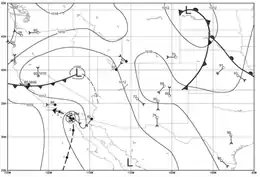1858 San Diego hurricane
The 1858 San Diego hurricane was a very rare hurricane that impacted southern California. It is the only known tropical cyclone to directly impact California as a hurricane, although other systems have impacted California as tropical storms. The storm caused considerable damage to many homes and other structures in southern California, mainly around San Diego.[2] A later estimate indicated that if a similar storm happened in 2004, it would have caused $500 million (2004 USD) in damage.
| Category 1 hurricane (SSHWS/NWS) | |
 Surface weather analysis and track of the storm approaching California | |
| Formed | September 1858 |
|---|---|
| Dissipated | October 2, 1858 |
| Highest winds | 1-minute sustained: 80 mph (130 km/h) |
| Lowest pressure | 994 mbar (hPa); 29.35 inHg (corrected sea level[1]) |
| Fatalities | Unknown |
| Damage | Unknown |
| Areas affected | Southern California, northwestern Mexico |
| Part of the pre-1900 Pacific hurricane seasons | |
Meteorological history
In late September 1858, a hurricane formed over the eastern Pacific Ocean, concurrent with a moderate El Niño event spanning 1857–58.[3][4] Unlike most east Pacific storms, this one accelerated toward the north-northeast. On October 2, it neared Southern California while weakening, due to cool sea surface temperatures and strong wind shear. The hurricane just missed making landfall, while turning to the west-northwest. The storm approached Santa Catalina Island in the Channel Islands and dissipated later on that day. There is some uncertainty to this reconstructed path.[1]
Impact
In San Diego, heavy rain fell, and property damage was significant; many homes lost their roofs, and a few even collapsed. In addition, trees were uprooted, and fences destroyed. A recently constructed windmill was also blown away completely. Three schooners, the Plutus, the Lovely Flora, and the X.L., were blown ashore, although only the X.L. suffered major damage.[1]
Rainfall in San Pedro was also heavy, but high winds were not reported. Parts of the embankment in the city were washed away, causing only around US$100 ($3,100.02 in 2019) in damage. The yacht Medora was washed ashore. Many reports claimed that the yacht was irreparable, but it was later claimed that the damage wasn't actually that great and could be repaired. A barge was destroyed, as was a large portion of the San Pedro wharf.[1]
El Monte was buffeted by high winds, damaging corn crops and trees. Los Angeles and Visalia noted large amounts of rain, as much as 7 inches (180 mm), but low winds.[1]
Two researchers with NOAA, Michael Chenoweth and Christopher Landsea reconstructed the path of the hurricane using accounts from newspapers of the strong winds. They estimated that if a similar storm were to have hit in 2004, it would have caused around US$500 million in damage.[5]
Records
The hurricane was the only hurricane known to impact California. Due to cold water temperatures from the Arctic, tropical cyclones usually weaken, and steering currents in the eastern Pacific steer storms away from land.
References
- Chenoweth, Michael; Landsea, Christopher (2004). "The San Diego Hurricane of 2 October 1858" (PDF). Bulletin of the American Meteorological Society. 85 (11): 1689–1697. Bibcode:2004BAMS...85.1689C. doi:10.1175/BAMS-85-11-1689.
- "Remembering the San Diego Hurricane of 1858 | The Weather Channel - Articles from The Weather Channel | weather.com". The Weather Channel. Retrieved 2020-11-13.
- W. H. Quinn and V. T. Neal (1992). "The Historical record of El Niño events in Climate since AD 1500" (.TXT). National Oceanic and Atmospheric Administration. Retrieved January 18, 2016.
- Bill Patzert (October 17, 2012). "Could a Hurricane Ever Strike Southern California?". National Aeronautics and Space Administration. Retrieved January 18, 2016.
- Chenoweth, Michael; Landsea, Chris (2005-01-11). The San Diego Hurricane of October 2, 1858. AMS Forum: Living in the Coastal Zone, 11 January 2005. Retrieved from http://www.aoml.noaa.gov/hrd/hurdat/presentations/ams-sandiego.ppt#14.
